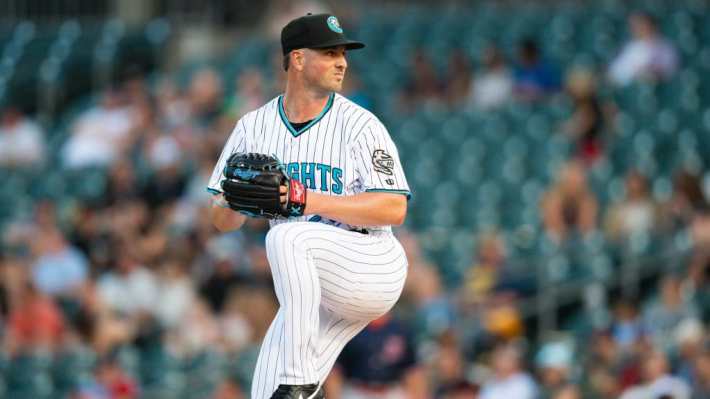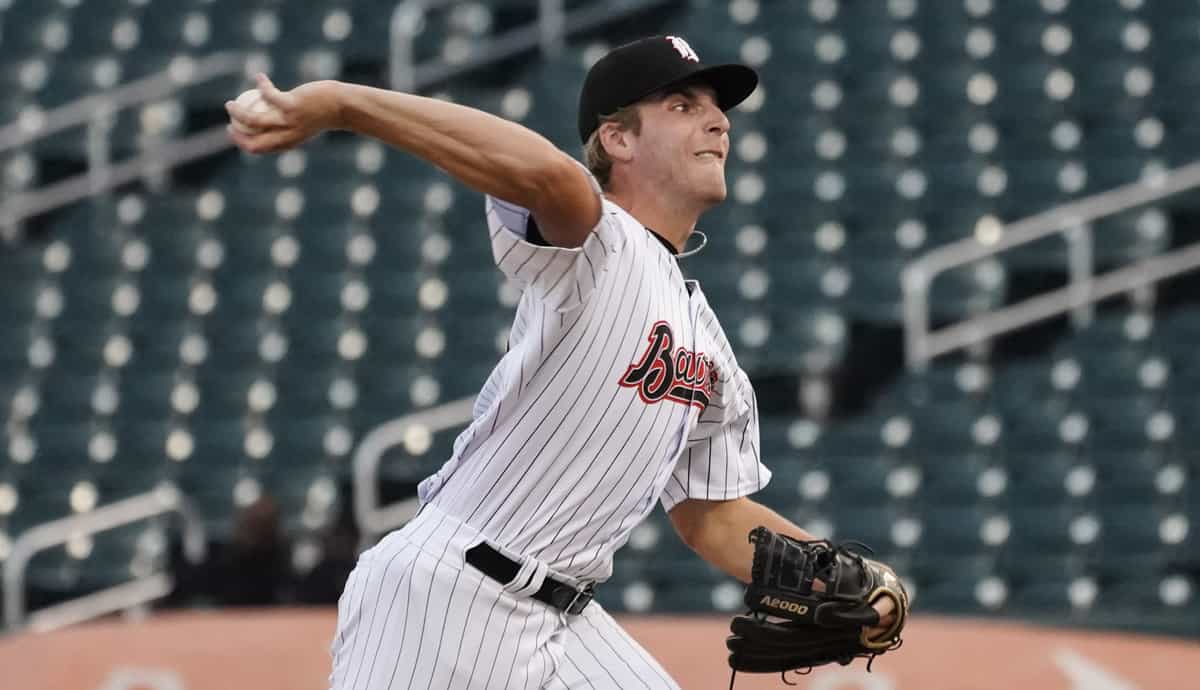The last installment of Prospect Week is never the least, because it turns out most players with the label of "prospect" have at least one significant obstacle obstructing their paths to the majors. The players who don't yet find themselves confronting a key shortcoming are 1) the best prospects in the world, 2) relatively new to the game, or 3) dealing with injury issues clouding the picture instead.
Whether the 14 White Sox prospects below are confronting their ceiling or merely getting around to a problem that just popped up, they're all worth following for specific reasons.
Jonathan Cannon: Arsenal
Thanks to season-opening injuries to their top three prospects, Cannon ended up being the White Sox’s Futures Game representative on the strength of his body of work at Winston-Salem. The White Sox promoted him to Birmingham afterward, and his work ceased being award-winning:
| Level | G | IP | H | HR | BB | K | ERA |
|---|---|---|---|---|---|---|---|
| A+ | 14 | 72.2 | 65 | 7 | 24 | 67 | 3.59 |
| AA | 11 | 48.1 | 61 | 8 | 15 | 39 | 5.77 |
But if you can table immediate expectations for a third-round pick going through his first full professional season, Cannon accomplished enough in 2023. He threw 121 innings over 25 starts and walked only 39 batters. In-zone misses led to more than his share of rough outings late in the year, but it probably gave him a better sense of what his stuff can and can't do.
Speaking of his stuff, he throws six pitches and has the arm strength to maintain 93-95 mph velocity deep into starts, so there’s a starting pitcher of some kind here. My sense is there’s a shorter path to the back end of the rotation as a sinker-cutter guy, but he’s trying to get more swing-and-miss on his slider to raise his profile. Cannon actually had reverse splits in 2023, but he's heavy enough on glove side offspeed movement that more traditional split issues could emerge in time. He has time to explore his options, especially since the White Sox are rebuilding, and any starts he gets in 2024 won’t make or break a season.

Nick Nastrini: Command
If Nastrini doesn’t stick as a starter, it’s not for a lack of arm strength, stuff or confidence. It’ll be just a few too many walks. He’s walked 11 percent of the batters he’s faced the last two years, and while he compensates with an equally above-average K rate, it’s a recipe for shorter-than-ideal starts, even when everything’s going well enough, and big innings when the sequencing blows up on him. The Dodgers had more advanced pitching prospects ready for auditions, which is why they felt comfortable sending him to the White Sox in the Lance Lynn/Joe Kelly deal.
His arsenal can be ideal for a right-handed starter – a fastball that can hit 97, a sharp curveball, a slider with adjustable tilt, and a respectable changeup that unlocks everything for him when it's working, which is why he gets some top-100 heat despite a minor-league ERA that’s hovered around 4.00 his entire career. The White Sox can offer him two things the Dodgers couldn’t: a clearer path to the rotation, and all the time in the world to figure it out.
Matthew Thompson: Command
Of the three high school pitchers the White Sox spent serious draft capital on between the 2019 and 2020 drafts, Thompson has experienced the most success, yet you can’t quite call him successful. He set career high in innings (124⅓) and strikeouts (136) in 2023, but it’s mostly a testament to his health and resilience.
When it comes to getting hitters out, he’s not making much progress closing the gap. His walk rate spiked from 8.5 percent to 15 percent in his jump to Double-A, as his athleticism still hasn't translated to a repeatable delivery. Fastball command is a problem, and because the counts are often working against him, he hasn’t created a suitable environment for working on his slider. There are stretches when his fastball has some jump and pairs with his curveball, and innings look easy. He just has a hard time repeating that, or finding workarounds with different sequences, which starts to sound like a description for why a starter becomes a reliever.

Terrell Tatum: Scaring pitchers
Tatum led the entire White Sox organization in walks with 100, which allowed him to lead the White Sox organization in stolen bases with 47, which allowed him to lead the entire White Sox organization in runs with 89. He finished the year hitting .248/.397/.367, and the White Sox made the math convenient by dividing his 552 plate appearances exactly 50/50 between Winston-Salem and Birmingham.
And that’s where you can start to see the problems:
- Winston-Salem: .268/.434/.421, 21.0 BB%, 25.0% K
- Birmingham: .230/.361/.314, 15.2 BB%, 29.0% K
Tatum struck out 80 times against just 13 extra-base hits with the Barons, and while the OBP flies for now, it usually only gets harder to tilt deep counts in his favor when pitchers have nothing to fear. He'll have to adjust his approach one way or another, and if he can turn more strikeouts (and fewer walks) into more hits, there’s a chance at a Scott Podsednik-like MLB existence.
José Rodríguez: Plate discipline
Events conspired against Rodríguez over the last eight baseball months. He broke his hamate at the end of the 2022 season, and if that posed any specific problems – Andrew Benintendi can sympathize here – the Southern League’s adoption of the enhanced-grip ball during the first half of 2023 didn’t help matters, either. His strikeout rate jumped by 10 percent, which is something his game can’t absorb. He hit just .264/.297/.450 with the Barons, and his first 19 games at Triple-A didn’t provide a change-of-scenery boost at the end of the year (.253/.270/.379).
If it turns out that his down year was due to the combination of those specific circumstances, then he might be able to shake it off and resume being an undersized middle infielder with a high motor, surprising power and a hit tool that compensates for a too-large strike zone, especially now that the pace-of-play rules benefit a guy with his good-not-great speed. That outcome puts him back in position to restore his standing as a possible solution at second base if everything breaks right, because he doesn’t turn 23 until May. There’s also the real chance that he’s run into the ceiling of his current approach, and he’s going to have to figure out a way to discern pitches he can damage. That seems to be the toughest last mile for prospects to close. Particularly White Sox prospects.
Braden Shewmake: Power
When the Braves drafted Shewmake in the first round of the 2019 draft, the idea was that his 6-foot-3-inch, 190-pound frame would be able to eventually generate more strength and power while maintaining the athleticism to play a fine everyday shortstop. He still can play shortstop, and every other infield position for that matter, but he never developed the ability to make quality contact on a regular basis, resulting in a sub-.700 OPS against high-minors pitching. He hit a career-high 16 homers, but the trade-off was a .299 OBP because he hits a ton of pop-ups.
The White Sox acquired him in the 5-for-1 Aaron Bummer trade as defensive depth up the middle, and he has a brief window to make the most of it before guys like Colson Montgomery and Bryan Ramos usurp him.
Shane Drohan: Rule 5 life
Drohan, Boston’s fifth-round pick in the five-round draft of 2020, put himself on the radar with an impressive 11 starts spanning the end of 2022 and the start of 2023 with Double-A Portland, then took himself off the radar with a walk-laden effort at Triple-A Worcester over the remainder of the season. He posted a 6.47 ERA with the WooSox, allowing 63 walks and five HBPs on top of 103 hits over 89 innings.
His prospect history shows an evolving arsenal, and it appears as though he has enough of a changeup or curveball to avoid right-handed barrels, but lefties have routinely exploited his lack of the standard lefty fastball-slider combination. Unless Brian Bannister has immediate fixes for him, the reverse splits might make it hard for him to hang out in a bullpen while the Sox abide by Rule 5 regulations … unless the Sox are losing a lot of games 10-3, and they just need multiple relief innings however they can find them.

Zach DeLoach: Contact
In an attempt to defy the ‘tweener label, DeLoach added more elevation to his profile in 2023, resulting in a career-high 23 homers for Triple-A Tacoma. It also resulted in a career-high 173 strikeouts and 27.8 percent K rate. When it all comes together, DeLoach has a handsome left-handed swing that can handle left-handed pitching, and he can also draw his share of walks. When it’s not going well, he’s whiffing on pitches in the zone to drag everything down, and his adequate defense isn’t strong enough to support a glove-first profile. Just like Nastrini, the White Sox can give him a far less crowded outfield situation to navigate while he attempts to make further refinements.
SHOP TALK: Zach DeLoach could provide pull-side power, but not in a way the White Sox haven't tried
Tim Elko: Plate discipline
The White Sox have already gotten their $35,000 worth out of their 10th round pick in the 2022 draft, as Elko bashed 28 homers and drove in 106 runs while hitting .295/.347/.527 across three levels. Like Tatum, he padded his stats against lower-level pitching, but he finally had to pay the tab for subpar plate discipline in Birmingham. His zone expanded on him dramatically, as he struck out 49 times against just three walks over 34 games, although the power was still evident on occasion.
Elko was a three-year captain at Ole Miss, and the White Sox will probably enjoy having him in minor-league lineups, dugouts and clubhouses over the next couple seasons, but he’ll have to figure out high fastballs and/or low-and-away breaking balls to prolong his playing days.
Tyler Schweitzer: Power
Selected two rounds after Cannon in the 2022 draft, Schweitzer also had a largely successful first professional season with warning flags that emerged in Birmingham. He posted a 3.94 ERA with 121 strikeouts over 107⅓ innings between Winston-Salem and Birmingham at age 22, all of which is good. His walk rate nearly doubled from High-A to Double-A, which isn’t.
The walks are partially a result of his willingness to throw any of his pitches at any time. It mostly comes down to whether his stuff is good enough to be in the zone a necessary amount. When it works, he’s savvy. When it doesn’t, it’s nibbling.
DJ Gladney: Plate discipline
The overall line shows that Gladney hit .243/.308/.475 for the Winston-Salem Dash in his age-21 season, but he seldom looked like a .243/.308/.475 hitter for any given period of time. He ran hot, like when he came out blasting .323/.354/.677 with 32 RBIs over his first 23 games. He also ran cold, like when he hit .188/.263/.313 over his next 46 games.
He ended the year on one of those upswings, hitting .284/.365/.662 over his final 21 games, which also happened to be when he returned from a two-week stay on the injured list. The power is legit, and while the strikeout rate is still too high for A-ball (27.9 percent), it’s improving (32.6 percent in 2022). He still has a ways to go before he can close his strikeout-to-walk rate enough to be a threat, but he’s been a project since the White Sox drafted him out of the 16th round in 2019, and there are signs of progress.
Wes Kath: Contact
Kath led the White Sox organization with 168 strikeouts despite finishing 22nd in the farm system in plate appearances. Contact has been an issue for Kath since the White Sox selected him in the second round of the 2021 draft. Rival scouts were skeptical of the bat speed handling pro velocity on draft night, and Kath immediately developed a close relationship with the organization's high-velocity pitching machine to counter the deficiency. While he was occasionally able to tap into his power with some hot stretches at Kannapolis in 2022, a 43-percent strikeout rate against High-A pitching is impossible to produce around, and he wore a .193/.275/.311 line as a result.
Jared Kelley: Control
Kelley is the Kath of pitchers – a second-round pick whose draft-year evaluation might’ve been warped by a pandemic-shortened prep career. He sat in the upper-90s but was physically maxed out on draft night beyond a quixotic quest to add a breaking ball alongside his plus changeup.
It also seems like the White Sox have let seven-figure bonuses guide their handling of them, rather than the results. They also made Kelley a part of Project Birmingham in 2022 despite a so-so season in Kannapolis, and then they let him issue 29 walks over 23 innings with the Barons after a midseason promotion in 2023 as well as a move to relief, even though he was just 21 years old the whole time.
It probably doesn't matter as long as his velocity is backed up to mid-90s instead of high-90s, but it's a little too reminiscent of the Buddy Bell era of White Sox prospects for my taste.
Loidel Chapelli: Position
Chapelli, one of Marco Paddy’s non-teenage signings out of Cuba, went from being too old for the DSL to younger than the competition in Winston-Salem. Considering the lack of stateside experience in between, he handled the jump well enough. Chapellí hit .254/.361/.411 with 20 doubles, six triples, 10 homers and 26 stolen bases, and that production was back-loaded (.301/.406/.465 over last 48 games). He was an effective presence at the top of the Winston-Salem order after Tatum moved up to Birmingham.
The White Sox moved Chapelli from the outfield to second base, and he hasn’t looked like a natural in the games I’ve watched him. He kinda has to play there, though, because at 5-foot-8, he doesn’t really have anywhere else to go. His smaller frame also potentially creates Tatum-like issues against more advanced pitching, where the combination of deep counts and lack of natural leverage leads him into a problematic strikeout rate. That part remains theoretical for now.





